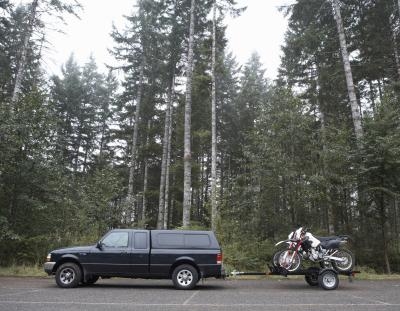
Whether you need to protect your cargo from the elements or keep the contents private, a homemade utility trailer enclosure may be an effective solution. Most utility trailers are equipped with stake mounts welded to the inside frame. A trailer enclosure can be built using plywood sheets and mounted to the frame using 1-by-4-inch boards, commonly known as 1-by-4s. Enclose your trailer and rest easy knowing that your cargo will be safe, secure and concealed from view.
Measure and note the separation distance between stake-mount pairs on the front, rear and sides of the trailer frame. Measure from the inside edges of the mounts. The side mounts as well as the front and rear mounts should have equal separation distances.
Measure the stake-mount insertion depth. This measurement should fall between 3 and 5 inches and will be used to assess the total length of each wall's leg extensions.
Cut six 1-by-4s to a length that matches the stake-mount pair separation on the sides of the trailer. Cut six 1-by-4s to a length that matches the stake-mount pair separation on the front and rear of the trailer. These twelve boards will be used as the horizontal framing boards for the enclosure walls.
Cut eight 1-by-4s to a length of 4 feet plus the insertion depth of the stake mounts. Each board length should measure between 51 and 53 inches, depending on the insertion depth. These boards will be used as vertical leg extensions for mounting the walls to the trailer.
Frame the two 48-inch-square plywood side walls. Lay three horizontal boards, cut to the side stake-mount separation measurements, at the top, middle and bottom centers of each plywood board. Allow equal space on either side of the 1-by-4s. Fasten the boards to the plywood using a screw gun and placing two wood screws at each end.
Lay two vertical leg extension boards along either side of the horizontal boards attached to the plywood walls. Allow the excess vertical length to extend from the bottoms of the plywood boards. Fasten the vertical boards with a screw gun, using two wood screws each, at the top, middle and bottom. The 1-by-4 framing should resemble a stepladder with legs extending from the bottom of the boards.
Frame the 38 1/2-by-48-inch front and rear plywood walls using the same procedure used for the side walls. Orient the plywood so that the 38 ½-inch sides are horizontal. Lay the three horizontal boards at the top, middle and bottom centers of each plywood board. Lay two vertical extension legs along either side of the horizontal boards. Fasten the boards using wood screws and a screw gun.
Place the 40-by-48-inch plywood board flat on the trailer frame. Drill 3/8-inch screw holes through the plywood to accommodate the frame mounting holes. Fasten the board to the frame using lag screws and a socket wrench.
Mount the front and side walls to the trailer frame by inserting the leg extensions into the corresponding stake mounts.
Apply a line of glue along either edge of the front wall. Sandwich the front wall between the side walls. Drill 3/8-inch screw holes to accommodate two equally spaced steel angles mounted along each vertical corner. Fasten the steel angles using lag screws and a socket wrench.
Apply a line of glue along the top edge of the front and side walls. Place the 40-by-54-inch board atop the three-sided box. Allow the excess to extend from the rear of the trailer. Drill 3/8-inch screw holes to accommodate two equally spaced steel angles mounted along each of the three top corners. Fasten the steel angles using lag screws and a socket wrench.
Mount the rear wall to the rear trailer frame stake mounts. Drill 3/8-inch screw holes to accommodate two equally spaced rotating hasp hinges along either rear vertical corner of the box. The hinge components should be mounted to the outer edges of the side walls and the corresponding rotating cylinder components should be mounted to the rear wall. Fasten the hasp hinge assemblies using lag screws and a socket wrench. The hasp hinges should latch over the cylinders and the cylinders should rotate to lock the hinges in place. This will secure the rear wall during travel and allow quick access when loading.
Weatherproof the enclosure by applying silicone sealant along the front and top corners and around all the lag screws. The rear-ceiling overhang should divert water runoff to the rear of the trailer.